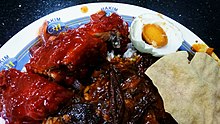food.wikisort.org - Dish
Nasi kandar is a popular northern Malaysian dish, which originates from Penang. It was popularized by Tamil Muslim traders from India. It is a meal of steamed rice which can be plain or mildly flavored, and served with a variety of curries and side dishes.
This article needs additional citations for verification. (October 2016) |
 Nasi kandar served together with fried chicken, salted egg and Pappadom. | |
| Type | Dish |
|---|---|
| Course | Lunch and dinner |
| Place of origin | Malaysia[1] |
| Region or state | Penang |
| Created by | Malaysian Indian |
| Main ingredients | Rice, meat and curry |
Etymology
The name nasi kandar came about from a time when nasi (rice) hawkers or vendors would balance a kandar pole on their shoulder with two huge containers of rice meals. Today, many Indian Muslim or “Malaysian Mamak” restaurants (e.g. the national chain Pelita Nasi Kandar) include "nasi kandar" in their name.
History
Hameediyah, is recognized as Penang's oldest nasi kandar restaurant, originally started under a tree at a field in Lebuh Campbell, Penang, in 1907.[2] After 90 years, nasi kandar goes back to Chennai, when Pelita Samudera Pertama opened a branch there. In 2022, the first Nasi Kandar restaurant opened in Japan, the first-ever nasi kandar speciality store serving authentic Malaysian-Indian cuisine in the country.[3]
Description

The rice for a nasi kandar dish is often placed in a wooden container about three feet high, giving it a distinctive aroma. The rice is accompanied by side dishes such as fried chicken, curried beef spleen, cubed beef, lamb, fish roe, fried prawns or fried squid.[4] The vegetable dish would usually be (brinjal or "terong") (aubergine), okra (lady fingers or "bhindi") or bitter gourd. A mixture of curry sauces is poured on the rice. This is called 'banjir' (flooding) and imparts a diverse taste to the rice.
Traditionally, nasi kandar is always served with its side dishes on a single plate. Nowadays, small melamine bowls are used for the side dishes. Nevertheless, the curry sauce mix is always poured directly onto the rice.
In recent years, several chain restaurants have appeared such as Nasi Kandar Shaaz, Nasi Kandar Subaidah, Nasi Kandar Nasmir, Pelita Nasi Kandar, Nasi Kandar Astana, Q-Bistro Nasi Kandar and Kayu Nasi Kandar. Purists have disputed its taste compared to the original Penang versions. In parts of northern Peninsular Malaysia, the rice is coloured yellow with herbs and the dish is referred to as "nasi ganja", though in fact no "ganja" (cannabis) is actually used in its preparation.
See also
- Mamak stall
- Banana leaf rice
References
External links
На других языках
- [en] Nasi kandar
[es] Nasi kandar
Nasi Kandar se trata de un plato muy popular en la cocina malaya, que posee su origen en Penang. Se trata de un simple plato de arroz cocido y al que se añade alguna especie, se suele servir con una variedad de currys de acompañamiento. La palabra Nasi Kandar proviene de un tiempo en el que nasi los vendedores de [arroz] callejeros podían kandar [balancear] los contenedores en sus espaldas. El nombre persistió y hoy en día la palabra Nasi Kandar es vista como un plato musulmán tamil o de los"restaureantes malasios" y musulmanes-indios que ofrecen este plato de arroz.Другой контент может иметь иную лицензию. Перед использованием материалов сайта WikiSort.org внимательно изучите правила лицензирования конкретных элементов наполнения сайта.
WikiSort.org - проект по пересортировке и дополнению контента Википедии